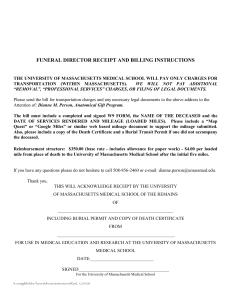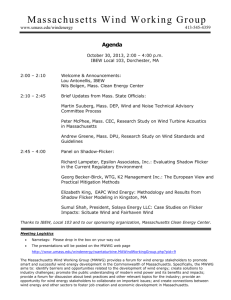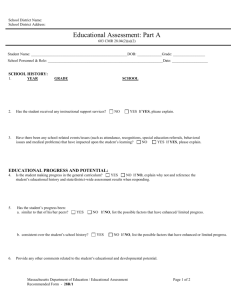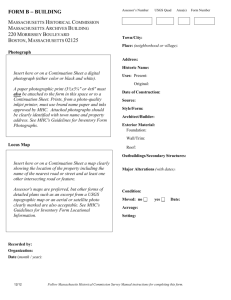Teacher Guide - Lafayette Durfee House
advertisement
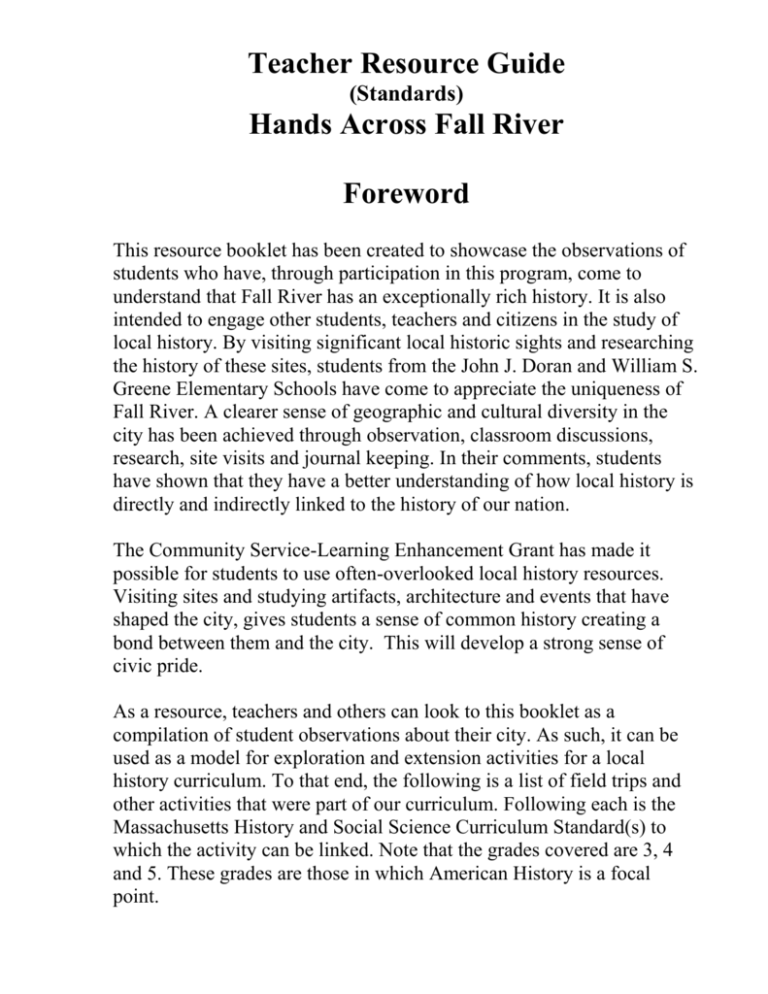
Teacher Resource Guide (Standards) Hands Across Fall River Foreword This resource booklet has been created to showcase the observations of students who have, through participation in this program, come to understand that Fall River has an exceptionally rich history. It is also intended to engage other students, teachers and citizens in the study of local history. By visiting significant local historic sights and researching the history of these sites, students from the John J. Doran and William S. Greene Elementary Schools have come to appreciate the uniqueness of Fall River. A clearer sense of geographic and cultural diversity in the city has been achieved through observation, classroom discussions, research, site visits and journal keeping. In their comments, students have shown that they have a better understanding of how local history is directly and indirectly linked to the history of our nation. The Community Service-Learning Enhancement Grant has made it possible for students to use often-overlooked local history resources. Visiting sites and studying artifacts, architecture and events that have shaped the city, gives students a sense of common history creating a bond between them and the city. This will develop a strong sense of civic pride. As a resource, teachers and others can look to this booklet as a compilation of student observations about their city. As such, it can be used as a model for exploration and extension activities for a local history curriculum. To that end, the following is a list of field trips and other activities that were part of our curriculum. Following each is the Massachusetts History and Social Science Curriculum Standard(s) to which the activity can be linked. Note that the grades covered are 3, 4 and 5. These grades are those in which American History is a focal point. Geography of Fall River Standard 3.1 On a map of the United States locate the New England states. On a map of Massachusetts locate major cities and towns. Standard 3.8 On a map of Massachusetts, locate the class’s home town or city and its local geographic features and landmarks. Standard 4.8 On a map of the world locate the United States, the Atlantic and Pacific Oceans … Standard 4.9 On a map of the United States locate the current boundaries of the United States. Locate the New England States, etc. Standard 4.10 Identify the states, state capitals, and major cities in each region. Standard 5.10 On a map of North America, indentify the first 13 colonies and describe how regional differences in climate, types of farming, populations and sources of labor shaped their economies and societies through the 18th century. Field Trip – Quequechan River – bus tour with stops at various locations including snack/picnic Standard 3.8 On a map of Massachusetts, locate the class’s home town or city and its local geographic features and landmarks. Standard 5.10 On a map of North America, indentify the first 13 colonies and describe how regional differences in climate, types of farming, populations and sources of labor shaped their economies and societies through the 18th century. Standard 5.11 Explain the importance of maritime commerce in the development of the economy of colonial Massachusetts, using the services of historical societies and museums. Presentation - Native Americans and the colonists – Colonial Trading Post Standard 3.2 Identify the Wampanoag and their leaders at the time the Pilgrims arrived and describe their way of life. Standard 3.11 Identify when the students’ own town or city was founded and describe the different groups of people who have settled in the community since its founding. Standard 4.15 Describe the diverse nature of the American people by identifying the distinctive contributions of … A. indigenous peoples, … Standard5.6 Explain the early relationship of the English settlers to the indigenous peoples in North America, including the differing views on ownership of land and the conflicts between them (e.g. the Pequot and King Philip’s War). Field Trip - The Battle of Fall River – bus tour with stop at a site with similar topography to battle site. Standard 3.5 Explain important political, economic, and military developments leading to and during the American Revolution. Standard 3.9 Identify historic buildings, monuments and sites in the area and explain their purpose and significance. Standard 5.17 Describe the major battles of the Revolution and explain the factors leading to American victory and British defeat. Lafayette / Durfee House – 18th Century / Colonial Period Standard 3.5 Explain important political, economic, and military developments leading to and during the American Revolution. Standard 3.9 Identify historic buildings, monuments and sites in the area and explain their purpose and significance. Standard 3.12 Explain how objects or artifacts of everyday life in the past tell us how ordinary people lived and how everyday life has changed. Standard 4.15 Describe the diverse nature of the American people by identifying the distinctive contributions of … C. major European immigrant groups. Standard 5.9 Explain the reasons that the language, political institutions and political principles of what became the United States of America were largely shaped by English colonists … Standard 5.10 On a map of North America, indentify the first 13 colonies and describe how regional differences in climate, types of farming, populations and sources of labor shaped their economies and societies through the 18th century. Standard 5.11 Explain the importance of maritime commerce in the development of the economy of colonial Massachusetts, using the services of historical societies and museums. Public Library – Research Topics Standards here are dependent on student research topics. Slide presentation & discussion w/ Spinner Standard 3.8 On a map of Massachusetts, locate the class’s home town or city and its local geographic features and landmarks. Standard 3.9 Identify historic buildings, monuments and sites in the area and explain their purpose and significance. Standard 3.11 Identify when the students’ own town or city was founded and describe the different groups of people who have settled in the community since its founding. Standard 3.13 Give examples of goods and services provided by their local businesses and industries. Standard 3.14 Give examples of tax-supported facilities and services provided by their local government, such as pubic schools, parks, recreational facilities, police, fire departments and libraries. Standard 4.16 Identify major immigrant groups that live in Massachusetts and where they now live in large numbers. Standard 5.11 Explain the importance of maritime commerce in the development of the economy of colonial Massachusetts, using the services of historical societies and museums. Field Trip – Fall River Historical Society – 19th Century Standard 4.16 Identify major immigrant groups that live in Massachusetts and where they now live in large numbers.. Standard 5.11 Explain the importance of maritime commerce in the development of the economy of colonial Massachusetts, using the services of historical societies and museums. Standard 5.33 Explain the importance of the China trade and the whaling industry to 19 th century New England and give examples of imports from China Standard 5.35 Identify the key issues that contributed to the onset of the Civil War. A. the debate over slavery and westward expansion B. diverging economic issues Field Trip – Historic Fall River - An Overview Standard 3.8 On a map of Massachusetts, locate the class’s home town or city and its local geographic features and landmarks. Standard 3.9 Identify historic buildings, monuments and sites in the area and explain their purpose and significance. Standard 3.11 Identify when the students’ own town or city was founded and describe the different groups of people who have settled in the community since its founding. Standard 3.13 Give examples of goods and services provided by their local businesses and industries. Standard 3.14 Give examples of tax-supported facilities and services provided by their local government, such as pubic schools, parks, recreational facilities, police, fire departments and libraries. Standard 4.16 Identify major immigrant groups that live in Massachusetts and where they now live in large numbers. Standard 5.11 Explain the importance of maritime commerce in the development of the economy of colonial Massachusetts, using the services of historical societies and museums. Field Trip – North Watuppa Pond & Water Filtration Plant Standard 3.8 On a map of Massachusetts, locate the class’s home town or city and its local geographic features and landmarks. Standard 3.9 Identify historic buildings, monuments and sites in the area and explain their purpose and significance. Standard 3.11 Identify when the students’ own town or city was founded and describe the different groups of people who have settled in the community since its founding. Standard 3.13 Give examples of goods and services provided by their local businesses and industries. Standard 3.14 Give examples of tax-supported facilities and services provided by their local government, such as pubic schools, parks, recreational facilities, police, fire departments and libraries. Playtime & Cooking in the 1700’s Standard 3.12 Explain how objects or artifacts of everyday life in the past tell us how ordinary people lived and how everyday life has changed. Standard 4.15 Describe the diverse nature of the American people by identifying the distinctive contributions of … C. major European immigrant groups.

